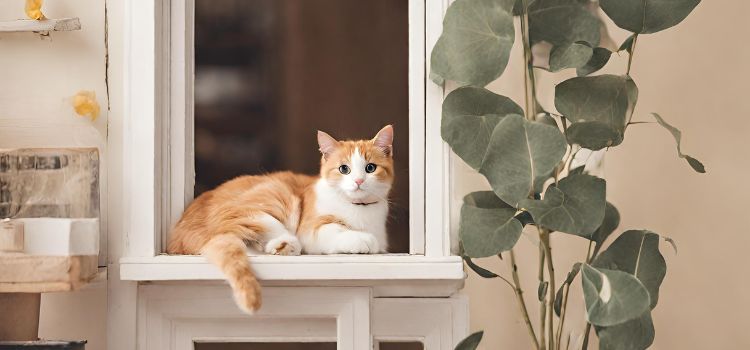As an Amazon Associate committed to the mission of improving the lives of our readers, Live-Clear.com receives a small commission from eligible purchases made through our affiliate links. This revenue enables us to keep producing insightful articles and other material.
To introduce cats in a small apartment, start by creating separate spaces for each cat. In a small living space, it is important to create a harmonious environment for multiple cats to coexist peacefully.
By providing each cat with their own designated area, you can ensure that they have their own space to relax and feel safe. This introduction process may take some time and patience, but it is essential for the well-being of both cats.

Gradually allow the cats to interact under supervised conditions and provide plenty of positive reinforcement and rewards to encourage positive associations between the cats. With a gradual and careful approach, you can successfully introduce cats in a small living space.
Creating A Happy Home For Cats In A Small Apartment
Create a happy home for cats in a small apartment by gradually introducing them to their new environment, providing designated spaces for them to explore and play, and incorporating vertical elements for climbing and perching. Additionally, ensure that each cat has their resources and territory to prevent territorial disputes.
Assessing Your Apartment Space
Consider available space for a cat to move comfortably. Ensure there are hideaway spots for privacy. Consider investing in cat trees or shelves to create vertical space for climbing and lounging. It’s also important to provide scratching posts and toys to keep your cats mentally and physically stimulated. By creating a stimulating and spacious environment for your cats, you can help them feel happy and content in your small apartment.
Preparing Your Apartment For A New Cat
Set up cat furniture like scratching posts or perches. Create feeding and litter areas in inaccessible locations. Make sure there are plenty of cozy spots for your cat to curl up and rest, such as soft blankets or cat beds. Keep their food and water dishes in a quiet area away from their litter box. Consider adding some interactive toys or puzzle feeders to keep them entertained and engaged. By creating a comfortable and stimulating environment, your new feline friend will feel right at home in your apartment.
Selecting The Right Cat For Your Apartment
Choose a cat compatible with smaller living spaces. Consider temperament suitable for apartment living. Some breeds, such as the Scottish Fold or Ragdoll, are known for their calm and laid-back personalities, making them excellent choices for apartment living. It’s also important to consider the age of the cat – older cats or kittens can adapt well to apartment living, while high-energy breeds may struggle in a smaller space.
Before bringing a cat home, spend some time with different cats at a shelter to see which one best fits your lifestyle and living situation. By taking the time to select the right cat for your apartment, you can ensure a happy and harmonious living environment for both you and your new feline companion.
Introducing Your Cat To The Apartment
Are you introducing your cat to a small apartment? Here’s how to do it right and create a harmonious living environment for both you and your furry friend.
Creating A Safe Space
Creating A Safe Space for your cat is essential when introducing them to a new apartment. Make sure to provide hiding spots, scratching posts, and a comfortable bed for them to feel secure. Additionally, slowly introduce them to each room in the apartment to prevent them from getting overwhelmed. With patience and a gradual approach, your cat will soon feel right at home in their new living space.
Remember also to provide plenty of toys and interactive activities to keep your cat mentally stimulated and entertained. This will help prevent boredom and potentially destructive behavior. It’s essential to establish a routine for feeding, playtime, and litter box maintenance to help your cat feel secure and settled in their new environment. By taking these steps, you can help your cat adjust to their new apartment and ensure a happy and healthy living situation for both of you.
Gradual Introduction To The Home
Gradually introduce your cat to the different rooms in your apartment, starting with one room at a time so they can explore and adjust at their own pace. Give them plenty of time to satisfy their curiosity and become familiar with their new surroundings. This slow introduction will help your cat feel more comfortable and secure in their new home, reducing stress and anxiety. Remember to be patient and provide lots of love and reassurance as they settle in. With time and patience, your cat will soon feel right at home in their new apartment.
Introducing To Other Pets (if Applicable)
Slowly introduce your cat to any other pets in the household, allowing them to sniff and observe each other from a safe distance. Supervise their interactions closely, stepping in if any aggression or fear is displayed. Encourage positive play and reinforcement, rewarding good behavior with treats or praise. With time and patience, your pets will learn to coexist peacefully and may even become friends. Remember always to prioritize the safety and well-being of all animals involved.

Setting Up A Cat-friendly Environment
When it comes to introducing cats in a small apartment, creating a cat-friendly environment is crucial for their well-being and happiness. By providing them with the necessary vertical space, a cozy sleeping area, and a playful environment, you can ensure that your feline friends feel comfortable and at home in their new living space.
Providing Vertical Space
Cats love to climb and observe their surroundings from above. To meet this natural instinct, it is important to provide them with ample vertical space in your small apartment. This can be achieved by installing cat shelves or a cat tree that allows them to climb and perch at different heights. Providing such vertical spaces not only allows cats to exercise and satisfy their curiosity but also helps to prevent any potential conflicts or territorial behavior between multiple cats.
Designing A Cozy Sleeping Area
Good quality sleep is important for cats and having a dedicated cozy sleeping area can greatly contribute to their well-being. Design a comfortable and quiet space where your cats can rest undisturbed. Consider providing cat beds or blankets in different areas of your apartment, allowing your cats to choose their preferred spot. Additionally, placing their sleeping area away from excessive noise or high traffic areas will help create a peaceful environment where they can relax and recharge.
Creating A Playful Environment
Cats are curious and playful creatures, and it is essential to provide them with opportunities for mental and physical stimulation. Engage your cats with interactive toys such as wand toys, balls, or puzzles, which can help redirect their energy in a positive way. Scatter toys and scratching posts around your apartment to encourage play and prevent any destructive behaviors caused by boredom. By creating an engaging and playful environment, you can ensure that your cats remain active and entertained in their small living space.
Establishing A Routine For Your Cat
Establishing a routine is crucial for the well-being of your cat, especially in a small apartment where space can be limited. A consistent schedule for feeding, litter box maintenance, and exercise not only provides structure for your cat but also helps them feel secure in their environment. By following a routine, you can create a harmonious living situation for both you and your feline friend.
Feeding Schedule
Creating a regular feeding schedule is essential for your cat’s health and can also help in managing their behavior. Decide on specific mealtimes and stick to them each day, ensuring that they receive the proper portions according to their age and weight. Consider placing their feeding station in a quiet, designated area, away from their litter box, to provide a calm environment for them to enjoy their meals.
Litter Box Placement And Maintenance
Selecting the right spot for your cat’s litter box is important in a small apartment. Place it in a quiet and easily accessible area, away from their feeding station. Keep the litter box clean by scooping waste daily and regularly changing the litter. This regular maintenance will encourage your cat to use the litter box consistently and prevent accidents throughout the apartment.
Daily Exercise And Playtime
Your cat’s physical and mental well-being relies on regular exercise and playtime. Incorporate daily play sessions, such as interactive toys or a feather wand, to keep your cat active and engaged. Designate a specific time each day for play and exercise to establish a routine that your cat can anticipate and look forward to.

Ensuring Mental Stimulation To Introduce Cats In A Small Apartment
Cats, despite being independent creatures, can become bored and stressed when confined to a small apartment. Ensuring mental stimulation for your cat is crucial to their well-being. By incorporating interactive toys, window perches, and cat TV, you can provide them with the mental and physical challenges they need to thrive.
Interactive Toys And Puzzles
Promote mental stimulation and physical activity by incorporating interactive toys and puzzles into your cat’s environment. These toys encourage problem-solving and mimic hunting behaviors, keeping your cat engaged and entertained. Invest in toys that dispense treats or engage your cat’s sense of curiosity, such as puzzle feeders, wand toys, or laser pointers.
Window Perches And Bird Feeders
Provide your cat with window perches to offer them a vantage point to observe the outside world. This can offer mental stimulation through visual and auditory enrichment, allowing them to watch birds, insects, and other outdoor activities. Consider installing a bird feeder outside the window to attract wildlife and provide your cat with an engaging source of entertainment.
Cat Tv And Nature Sounds
Cat TV, or videos designed specifically for cats, can capture your cat’s attention and provide visual and auditory stimulation. Additionally, playing nature sounds such as bird calls or rustling leaves can create a calming and enriching environment for your cat, reducing stress and boredom. Consider incorporating these elements into your cat’s daily routine to ensure continuous mental stimulation.
Dealing With Potential Challenges Of Introduce Cats In A Small Apartment
Living in a small apartment presents a unique set of challenges, especially when it comes to introducing cats. With limited space, managing odors, minimizing noise, and providing enough room for your furry friends to explore can be tricky. However, with a few simple strategies, you can create a harmonious environment for you and your cats. Let’s dive into some effective techniques for dealing with these potential challenges.
Managing Odors To Introduce Cats In A Small Apartment
Owning a cat in a small apartment means that odors can quickly become a problem. To keep your living space smelling fresh, try implementing these odor management strategies:
- Clean the litter box regularly: Scooping the litter box daily and completely changing the litter on a regular basis can help prevent odors from accumulating.
- Choose a high-quality litter: Opt for a litter that is designed to control odors. Look for options that are fragrance-free and made from natural, clumping materials.
- Use an air purifier: Investing in an air purifier with a HEPA filter can help eliminate pet odors and keep the air clean in your small apartment.
- Open windows for ventilation: Allowing fresh air to circulate can help reduce odors and create a more pleasant living environment.
Minimizing Noise To Introduce Cats In A Small Apartment
Living in close quarters means that minimizing noise is essential for maintaining a peaceful atmosphere. Here are some tips to help keep the noise level down:
- Provide hiding spots: Cats often seek out quiet and cozy spaces. Offer your cats hiding spots such as a comfortable cat bed or a dedicated cat tree where they can retreat and feel safe.
- Invest in quiet toys: Look for toys that are designed to minimize noise, such as soft plush toys or interactive puzzle toys. Avoid toys with bells or squeakers that could potentially disturb your neighbors.
- Set a play schedule: Establishing play sessions during quieter times of the day can help prevent excessive noise. Engage your cats in interactive play, using toys that won’t create disturbances for others.
Introduce Cats In An Apartment With Limited Space
Living in a small apartment means space is at a premium, but there are ways to make the most of what you have:
| Maximize vertical space: | Utilize tall cat trees or shelves that allow your cats to climb and perch, taking advantage of the vertical space in your apartment. |
|---|---|
| Create dedicated zones: | Designate specific areas for your cats’ essentials, such as a cozy corner for their litter box, a comfortable bed, and a feeding station. |
| Use space-saving furniture: | Consider investing in multi-functional furniture, like cat-friendly bookshelves or beds with built-in hiding spots, to maximize space usage for both you and your cats. |
By implementing these strategies, you can overcome the challenges of living in a small apartment and ensure a harmonious environment for both you and your feline companions. Remember, it’s all about finding creative solutions and making the most of the space you have available.

Maintaining A Healthy And Happy Cat
Discover effective tips on introducing cats in small apartments for a harmonious living environment. Help your feline friend adjust by creating separate spaces, providing vertical territory, and using calming techniques. Ensure a healthy and happy cat by prioritizing their wellbeing in a limited living space.
- Regular Veterinary Care: Regular check-ups essential for a cat’s. Schedule annual exams to monitor health and detect any issues early.
- Grooming and Hygiene: Brushing helps prevent hairballs and keeps the coat. Trim nails to avoid scratching furniture or people.
- Monitoring Stress Levels: Observe behavior changes indicating stress. Provide hiding spots for privacy and comfort in a small space.
Building A Strong Bond With Your Apartment Cat
Building a Strong Bond with Your Apartment Cat requires patience, understanding, and consistency. Spend quality time playing, grooming, and talking to your cat to build trust and a sense of companionship. Providing a safe and comfortable environment, with plenty of toys and scratching posts, will help your cat feel secure and happy in your apartment. Remember also to respect your cat’s boundaries and give them space when needed to ensure a solid and lasting bond.
Socializing And Bonding To Introduce Cats In A Small Apartment
- Introduce cats gradually.
- Provide safe spaces for each cat.
- Supervise initial interactions.
- Acknowledge their unique personalities.
Allowing your cats to socialize and bond at their own pace will help prevent any potential conflicts. Make sure each cat has its own designated space where it can retreat if it feels overwhelmed. Supervising their interactions, in the beginning, will help you intervene if needed and ensure a positive experience for both cats. Remember to acknowledge and respect each cat’s unique personality and preferences to foster a solid and lasting bond between them.
Training And Enrichment To Introduce Cats In A Small Apartment
- Use positive reinforcement techniques.
- Engage in interactive play sessions.
- Offer scratching posts and toys.
- Establish a routine for feeding and playtime.
Consistency is vital when it comes to training and enrichment for your cats. By using positive reinforcement techniques, you can encourage good behavior and strengthen your bond with them. Interactive play sessions not only provide exercise and mental stimulation but also create opportunities for bonding. Providing scratching posts and toys will satisfy their instincts and prevent destructive behavior. Establishing a routine for feeding and playtime will help your cats feel secure and well-cared for in their new environment. Remember to be patient and understanding as you help your cats adjust to their new routine and surroundings.
Positive Reinforcement To Introduce Cats In A Small Apartment
- Reward good behavior with treats.
- Use clicker training for skill learning.
- Consistency is vital in reinforcing positive actions.
- Patience and love go a long way in building trust.
By using positive reinforcement techniques, you can build a strong bond with your cats and help them adjust to their new home. Rewarding good behavior with treats and utilizing clicker training for skill learning will help your cats feel confident and secure in their environment. Consistency in reinforcing positive actions will ensure that your cats understand what is expected of them. At the same time, patience and love will help them feel safe and loved in their new surroundings. Remember to take the time to understand your cats’ individual needs and personalities, and be there for them as they navigate this new chapter in their lives.

Conclusion
Introducing cats in a small apartment can be a delicate task, but with patience and proper planning, it can be a smooth process. Remember to create separate spaces for each cat, gradually introduce their scents, and provide enough resources for both of them.
By implementing these techniques, you can ensure a harmonious living environment for your feline friends, even in a small space. Happy cat cohabitation!
Frequently Asked Questions For How To Introduce Cats In A Small Apartment
Yes, cats can happily coexist in a small apartment with proper introductions and resources.
Start with separate spaces, then use scent swapping and supervised mingling to ease their introductions.
Positive body language, decreased tension, and shared playtime signal successful cat introductions.
Yes, each cat needs their own litter box, food, water, and resting spots to ensure harmony in a small space.
Prevent resource competition and provide vertical spaces to reduce territorial stress in a small apartment.
Amazon and the Amazon logo are trademarks of Amazon.com, Inc, or its affiliates.



